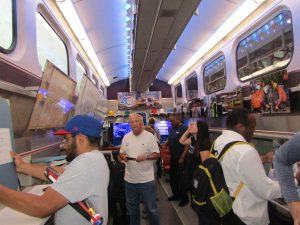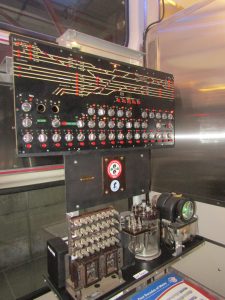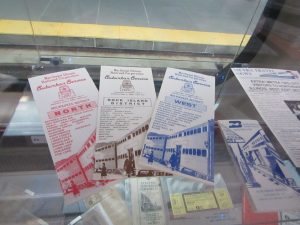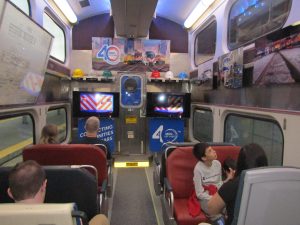Metra celebrates anniversary with museum train car
By Igor Studenkov For Chronicle Media — June 19, 2024
People check out the items inside the Metra museum train car. The museum car will be at the Ogilvie Transportation Center on Saturday, June 22, Union Station on July 6, and Millenium Station on July 20. (Photos by Igor Studenkov/For Chronicle Media)
Metra is taking its history on the road with a museum train car.
The commuter rail agency celebrated its 40th anniversary June 8, the date of the first meeting of the Commuter Rail Division of the Regional Transportation Authority Board of Directors. The familiar “Metra” brand name was adopted a year later, because the agency wanted a simpler and catchier identifier.
The agency was established to operate and subsidize commuter rail services throughout the Chicago area, something that was no longer profitable for private railroads.
The museum car was put together as part of the anniversary celebration. Visitors can look at artifacts such as vintage timetables and conductor uniforms, touch old locomotive controls, watch vintage ads and sit in the passenger seats from different decades.
The museum car will make its way to Chicago downtown terminals over the next few weeks. It will be at Ogilvie Transportation Center, the terminal for the three Union Pacific lines, on
Saturday, June 22, at Union Station on July 6, and Millenium Station, the terminal for Metra Electric line, on July 20.
Admission is free; and the car will be open at those locations from 1-4 p.m.
The museum car is a rehabbed gallery car that’s standard on lines such as the Rock Island District.

The Kensington Tower switchboard, which Metra employees estimate is at least 90 years old, is one of the museum exhibits.
Half of the car gives a peek of what those cars usually look like, with higher-back seats that don’t flip and have cupholders in the rear, and power outlets at some seats. The other half was essentially gutted – even the second-level seats were removed.
Over by the door, visitors get a look at the salvaged switchboard from Kensington Tower, the track switching tower that controls the complex railroad crossings on the Far South Side of Chicago where South Shore Line tracks split off from the tracks they share with the Metra Electric Line, crossing tracks shared by Canadian National freight trains and Amtrak trains. A Metra employee explained how the railroad employees operated the switches and how the signal lights used to alert them of any technical issues.
Further down, visitors get to see display cases with items such as train schedules from the early 1980s, train crew unforms, technical manuals for train cars Metra inherited from the freight railroads, and lanterns. Schematics for train locomotives and various photos are displayed up at what normally would be the train car’s second level.
There are some interactive pieces. Visitors can sit at train locomotive controls or sit in one of the seats that represent different train cars Metra used over the years.
When Chronicle Media visited the museum car, Metra was handing out 40th anniversary posters. The same posters are inserted in the latest issue of the agency’s quarterly newsletter.
The museum car is one of the several ways Metra is celebrating the milestone. Riders could take the trains for free June 8-9.
In a statement to the media, Metra Executive Director Jim Derwinski described the free rides and other activities as “our way to thank Chicago area residents for riding and supporting us for the last four decades.”
The History of Metra

Early Metra schedules are on display.
Freight railroads traditionally provided commuter rail service for the Chicago area, but the growth of highways and suburbanization in the mid-20th century made it increasingly less profitable. The Regional Transportation Authority was formed in 1974 to subsidize commuter lines and suburban bus companies.
However, when the Rock Island, and Chicago, Milwaukee, St. Paul and Pacific railroads went bankrupt in late 1970s, RTA formed the Northeast Illinois Railroad Corporation to operate what became known as Milwaukee District North, Milwaukee District West and Rock Island District lines.
In 1983, RTA was reorganized, establishing the Commuter Division. After the Board of Directors was selected and seated, the newly formed agency set out to create a unified identity for the lines it owned outright and the lines it was subsidizing. It considered CORD (for Commuter Rail Division), CORTA (Commuter Rail Division of the RTA) and TRAC (Total Rail Access), but it ultimately settled for Metra (a portmanteau of Metropolitan Rail)
Since then, Metra acquired what became known as the Metra Electric District Line and took over

Museum visitors check out the seats that Metra train cars have used during the past four decades.
operations on what became known as SouthWest Service and Heritage Corridor lines. Unlike the “district” lines, where Metra owns the tracks and operates the service, for the other lines, the freight railroads (Norfolk Southern and Canadian National) retain ownership of the tracks, but Metra operates the trains.
In 1994, Metra launched the North Central Service Line that used the Milwaukee West tracks it already owned until it reached Franklin Park, where it switched to the Canadian National-owned tracks to reach Antioch.
The BNSF Line maintains the same arrangement as before – Metra pays the BNSF Railway to operate the trains with their own crews. Union Pacific Railroad operates Union Pacific North, Northwest and West lines under the same model, but it has been working with Metra to transition them to “service” line models, keeping the ownership of the tracks while turning the service over to Metra.
The South Shore Line is operated by the Northern Indiana Commuter Transportation District rather than Metra, but it does get RTA funding to provide service to Chicago’s Hegewisch neighborhood, and it shares tracks with Metra Electric in most of the city.
While Metra closed some stations over the past four decades, it also expanded service. Aside from the North Central Service, it extended SouthWest Service from its original endpoint in Orland Park to Manhattan and extended the Union Pacific West from Geneva to Elburn.
Metra and the Illinois Department of Transportation is working on the most ambitious expansion yet, extending service to Rockford. The service would share Milwaukee District West tracks as far as Elgin before switching to Union Pacific-owned tracks the rest of the way. In another first, IDOT would subsidize the service the way it subsidizes state-wide Amtrak routes.







